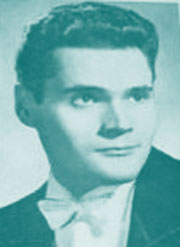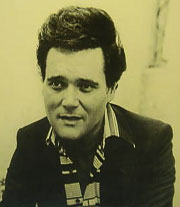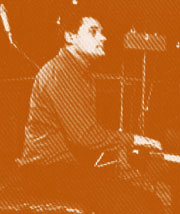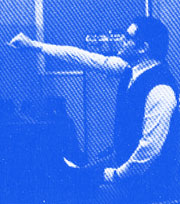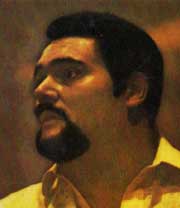Biography of Waldo de los Ríos
by Horacio Miguel Vasquez
Waldo de los Ríos
was born in Buenos Aires, September 7 1934. Real Name: Osvaldo
Nicolás Ferrara. As a prodigy child, he often accompanied
her mother Martha de los Ríos at the piano. She was a well known
Argentine folklore singer (1906-1995).
He is musically
formed in the Argentine National Conservatoire with Lita Spena,
Alberto Ginastera and Teodoro Fuchs.His beloved
classical composers were Maurice Ravel, Bela Bartok, Manuel de
Falla... Soon he started to work in Film music
He
also made collaboration like being part of a small ensamble
named "Frankie & his Clave Boys" (Waldo - piano, Horacio
Malvicino/Alain Debray - guitar, Jorge López Ruiz - bass and
"Pichi" Mazzei - drums) which made the early instrumental
backgrounds for "Los 5 latinos" first recordings (1957), a
famous Argentine vocal quintet inspired in the US group "The
Platters".
He had international projection since his own
composition, the "Suite Sudamericana / South American Suite" is
presented at a convention auditorium of his record company in
1961 (then Columbia, label which made the LP recording). His
talent is well appreciated by Percy Faith, Michel Legrand, Frank
Devol, and Andre Kostelanetz, who were present in that
performance.
With his orchestra he made the arrangements
and conduction of the first album of Alberto Cortez in 1961 (
Argentine singer later settled in Spain also ), who had been in
France and recorded the song "La Escalera / The Stairway" in
French under musical direction of Paul Mauriat" that year.
After a learning stay in Germany, he settled in Madrid,
Spain in 1962.
Then he made sporadic visits to Buenos
Aires, where he made some solo piano radio broadcast
participations between 1962 and 1965, which some cuts were
fortune compiled in a 2001 CD named "Solo Piano" (Melopea
Records).
Since 1964/5 Rafael Trabuchelli was the A&A and
producer of Hispavox, a leader record company in Spain. He
recorded a lot of the most emblematic and popular songs of that
time in that country. He put Waldo de los Rios under contract as
his assistant and the sound engineer Mike Lewellyn Jones from
Chile. They were recording an average of 100 records per year,
hit after hit, so they were able to obtain the most advanced
technology available in those years.
Rafael Trabucchelli,
who also is a musician who has composed a piano concerto which
was premiered in Teatro alla Scala di Milano a few years ago,
talked about his work for Hispavox and Waldo de los Ríos:
"Everybody's talking what the
'Torrelaguna Sound' is
(Hispavox highly appreciated quality sound recordings). I don't
really know. I just certainly know it was a sound world wide
appreciated. I think it was a great studio with the best
musicians available in conjunction with the run over imagination
from all collaborators I had. Among them was Waldo de los Ríos,
which is the most talented person I ever knew from all the music
world. We both created the 'Torrelaguna Sound'..."
Also
in those years he often conducts the Spanish Radio TV (TVE)
Orchestra in live Theatre concerts and radio TV emissions. He
also compose some issues of the successful "Historias para no
dormir / Don't sleep tales for" TVE thriller and suspense
series.
In 1966 he compose the Argentina-Spain
co-production film soundtrack "Pampa Salvaje /
Savage Pampas").
Waldo himself explain us:
"in this picture I was able
to make my musical dream true without difficulties and to be
able to employ all elements and styles which the image suggested
me. So I employed twelve tone series, free atonalism,
polyrhythms, etc. I could express freely myself, in accordance
with my feelings".
He confessed that this soundtrack and
his "Los Waldos" recording the following year, were the works he
was most satisfied with.
In 1967 he formed in Spain a
musical group with Argentine folk roots called "Los Waldos".
With this quintet he made the recording of "Waldo de los
Rios en Europa" album for Hispavox, which later would become an
icon of the Argentine folklore and is still surprising because
his unusual music conformation and originality on this genre,
with mastery and vanguard interpretation.
This formation
was integrated by Roque Rubion on vibes and electro acoustics
recorded effects tapes, the conductor César Gentilli in
"electron", a precursor of modern synthesizers, Alberto Carbia
in electric bass, Roberto Stella in drums and the unusual
absence of guitar for an Argentine folklore group. The notorious
Waldo piano mastery in this recordings place him in the centre
of the compositions. Some tracks had a precious use of supporting
strings, and some unusual harmony and rhythm changes are
employed, like the use of 10/8 in a chacarera (northern
Argentina folk song). This album had not big sales.
Miguel Ríos, a Spanish rock artist (Granada, June 7 1944)
recorded in 1969 "Himno a la Alegría/ Ode to Joy", a Waldo de
los Ríos arrangement conducted by himself of the 4th. movement
of IX Beethoven Symphony "Choral". This recording (originally
included in the Spanish Miguel Ríos album "DESPIERTA" - LP
HISPAVOX - HH (S) 11-182.- sold 7.000.000 copies all over the
world (appearing in the USA, UK, France, Germany, Japan, Sweden,
Italy, Austria, Holland, Canada charts).
In an interview
Miguel Ríos explained us:
"One Day Rafael Trabuchelli,
the A&A of my record company told me that Waldo de los Ríos had
an idea using the fourth movement of Beethovens's Ninth
Symphony, and I must admit I'd never heard of it!
When
they called me for the recording there was a whole symphony
orchestra. It was magnificent and sounded amazing. When I
started singing, it seemed really marvelous..."
This
recording sold 1 millon in USA, and 2,5 millon in Germany, being
7.000.000 all over the world!
In the 1969 fall he spent
Christmas in Buenos Aires with his family and made TV
appearances where all his talent is showed .
After
recording some instrumental easy listening albums in middle 60's
under his artistic name, he start to arrange classical music in
early 70's, adding original rhythm arrangements which include
Argentine folk percussion instruments in the orchestrations. His
recording of the first movement of the Mozart Symphony 40 is an
instant world wide hit which is followed by other Easy Listening
artists covers like Caravelli, Werner Müller, Ronnie Aldrich,
Raymond Lefèvre among others.
He also continue to arrange
and conduct for singers like the first recordings of Jeannette,
an English settled in Spain singer who appeared in the
soundtrack of 1971 Carlos Saura "Cria Cuervos" film starred by
Geraldine Chaplin.
He made live concerts in the Luna Park
of Buenos Aires, conducting an orchestra conformed with members
of the local National Symphony Orchestra and other prestigious
ensembles.
In 1973 he composed the "Concierto para
Guitarra Criolla"/Folk Guitar Concerto"
In those years he
explore different genres and made a lot of Symphonic
arrangements, many times avant garde.
In March 28, 1977 he
commits suicide in Madrid, victim of a deep depression.

